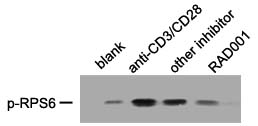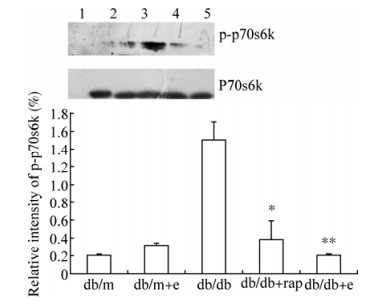
| Size | Price | Stock | Qty |
|---|---|---|---|
| 1mg |
|
||
| 5mg |
|
||
| 10mg |
|
||
| 25mg |
|
||
| 50mg |
|
||
| 100mg |
|
||
| 250mg |
|
||
| 500mg |
|
||
| Other Sizes |
|
Purity: ≥98%
A-674563 is a brand-new, powerful Akt1 inhibitor with possible anticancer properties. In cell-free assays, it binds to Akt with a Ki of 11 nM, exhibits modest potency against PKA, and has >30-fold selectivity for Akt1 over PKC. A-674563 reduced the proliferation of tumor cells in MiaPaCa-2 cells after a 48-hour treatment (EC50 = 0.4 μm). The phosphorylation of GSK3 and MDM2 was noticeably decreased in STS cells after treatment with A-674563. In STS cells treated with A563, Akt inhibition-induced G2 cells cycle arrest and apoptosis were also noted.
| Targets |
Akt1 (Ki = 11 nM); PKA (Ki = 16 nM); CDK2 (Ki = 46 nM); GSK3β (Ki = 110 nM); ERK2 (Ki = 260 nM); PKCδ (IC50 = 360 nM); RSK2 (Ki = 580 nM); MAPK-AP2 (Ki = 1.1 μM); PKCγ (Ki = 1.2 μM); Chk1 (Ki = 2.6 μM); CK2 (Ki = 5.4 μM); SRC (Ki = 13 μM)
|
|---|---|
| ln Vitro |
A-443654 can be converted to A-674563 by swapping the indole out for a phenyl moiety and obtaining oral activity. A-674563 has an EC50 of 0.4 M and inhibits the growth of tumor cells. [1] Although A-674563 does not directly inhibit Akt phosphorylation, it does inhibit it in a dose-dependent manner when it comes to phosphorylating Akt's downstream targets. Reduced downstream target phosphorylation of STS cells and inhibition of tumor cell growth are caused by Akt blockade induced by A-674563. In STS cells, A-674563 causes apoptosis and a G2 cell cycle arrest. [2]
|
| ln Vivo |
A-674563 increases plasma insulin in an oral glucose tolerance test at a dose of 20 mg/kg. A-674563 exhibits no appreciable tumor-inhibitory activity in monotherapy; however, the efficacy of the combination therapy is significantly higher than that of paclitaxel monotherapy. [1] Mice given A674563 (20 mg/kg/bid, p.o.) exhibit slower tumor growth and a greater than 50% reduction in tumor volume at the end of the study when compared to the control group. [2] Despite having a significantly improved PK profile and a 67% oral bioavailability in mice, A-674563 is 70 times less active than A-443654.[3]
|
| Enzyme Assay |
His-Akt1 and a biotinylated mouse Bad peptide are the substrates used in the kinase assay. The kinase assay is carried out at room temperature for 30 minutes in 50 μL of reaction buffer [20 mM HEPES, pH 7.5, 10 mM MgCl2, 0.1% (w/v) Triton X-100, 5 μM ATP (Km = 40 μM), 5 μM peptide (Km = 15 μM), 1 mM DTT, 60 ng of Akt1, and 0.5 μCi of [γ-33P]ATP] in the presence of different concentrations of A-674563. Each reaction is halted by adding 50 μL of termination buffer (0.1 M EDTA, pH 8.0, and 4 M NaCl). On streptavidin-coated FLASH plates, the biotinylated Bad peptides have been immobilized. After being washed with PBS-Tween 20 (0.05%), the 33P phosphopeptide captured on the FLASH plates is measured with a TopCount Packard Instruments γ counter.
|
| Cell Assay |
The cells on 96-well plates are gently washed with 200 μL of PBS. Normal growth media is diluted 1:10 with Alamar Blue reagent. According to the manufacturer's instructions, 100 M of the diluted Alamar Blue reagent is added to each well of the 96-well plates before the reaction is allowed to fully develop. An fmax Fluorescence Microplate Reader is used for the analysis, with the excitation and emission wavelengths both set to 544 nm. The manufacturer's SOFTmax PRO software is used to analyze the data.
|
| Animal Protocol |
Immunocompromised male scid mice are at 6 to 8 weeks of age. The 1×106 3T3-Akt1 or 2×106 MiaPaCa-2 and PC-3 cells in 50% Matrigel are inoculated s.c. into the flank. For early treatment studies, mice are randomLy assigned to treatment groups and therapy is initiated the day after inoculation. Ten animals are assigned to each group, including controls. For established tumor studies, tumors are allowed to reach a designated size and mice are assigned to treatment groups of equal tumor size (n=10 mice per group). Tumor size is evaluated by twice weekly measurements with digital calipers. Tumor volume is estimated using the formula: V=L×W2/2. A-443654 is given s.c. in a vehicle of 0.2% HPMC. A-674563 is given orally in a vehicle of 5% dextrose. Gemcitabine and paclitaxel are added to the assay.
|
| References | |
| Additional Infomation |
The kinase Akt is a key signaling node in regulating cellular growth and survival. It is implicated in cancer by mutation and its role in the downstream transmission of aberrant PI3K signaling. For these reasons, Akt has become an increasingly important target of drug development efforts and several inhibitors are now reaching clinical trials. Paradoxically it has been observed that active site kinase inhibitors of Akt lead to hyperphosphorylation of Akt itself. To investigate this phenomenon we here describe the application of a chemical genetics strategy that replaces native Akt with a mutant version containing an active site substitution that allows for the binding of an engineered inhibitor. This analog sensitive strategy allows for the selective inhibition of a single kinase. In order to create the inhibitor selective for the analog sensitive kinase, a diversity of synthetic approaches was required, finally resulting in the compound PrINZ, a 7-substituted version of the Abbott Labs Akt inhibitor A-443654.[2]
|
| Molecular Formula |
C22H22N4O
|
|---|---|
| Molecular Weight |
358.44
|
| Exact Mass |
358.179
|
| Elemental Analysis |
C, 73.72; H, 6.19; N, 15.63; O, 4.46
|
| CAS # |
552325-73-2
|
| Related CAS # |
552325-73-2; 2070009-66-2 (HCl);
|
| PubChem CID |
11314340
|
| Appearance |
White to yellow solid powder
|
| Density |
1.2±0.1 g/cm3
|
| Boiling Point |
624.4±55.0 °C at 760 mmHg
|
| Melting Point |
243.14° C
|
| Flash Point |
331.4±31.5 °C
|
| Vapour Pressure |
0.0±1.8 mmHg at 25°C
|
| Index of Refraction |
1.663
|
| LogP |
3.73
|
| Hydrogen Bond Donor Count |
2
|
| Hydrogen Bond Acceptor Count |
4
|
| Rotatable Bond Count |
6
|
| Heavy Atom Count |
27
|
| Complexity |
456
|
| Defined Atom Stereocenter Count |
1
|
| SMILES |
N[C@@H](CC1=CC=CC=C1)COC2=CC(C3=CC4=C(C=C3)NN=C4C)=CN=C2
|
| InChi Key |
BPNUQXPIQBZCMR-IBGZPJMESA-N
|
| InChi Code |
InChI=1S/C22H22N4O/c1-15-21-11-17(7-8-22(21)26-25-15)18-10-20(13-24-12-18)27-14-19(23)9-16-5-3-2-4-6-16/h2-8,10-13,19H,9,14,23H2,1H3,(H,25,26)/t19-/m0/s1
|
| Chemical Name |
(2S)-1-[5-(3-methyl-2H-indazol-5-yl)pyridin-3-yl]oxy-3-phenylpropan-2-amine
|
| Synonyms |
A674563; A 674563; A-674563
|
| HS Tariff Code |
2934.99.9001
|
| Storage |
Powder -20°C 3 years 4°C 2 years In solvent -80°C 6 months -20°C 1 month |
| Shipping Condition |
Room temperature (This product is stable at ambient temperature for a few days during ordinary shipping and time spent in Customs)
|
| Solubility (In Vitro) |
|
|||
|---|---|---|---|---|
| Solubility (In Vivo) |
Solubility in Formulation 1: 5.75 mg/mL (16.04 mM) in 10% DMSO + 90% (20% SBE-β-CD in Saline) (add these co-solvents sequentially from left to right, and one by one), suspension solution; with sonication.
For example, if 1 mL of working solution is to be prepared, you can add 100 μL of 57.5 mg/mL clear DMSO stock solution to 900 μL of 20% SBE-β-CD physiological saline solution and mix evenly. Preparation of 20% SBE-β-CD in Saline (4°C,1 week): Dissolve 2 g SBE-β-CD in 10 mL saline to obtain a clear solution. Solubility in Formulation 2: ≥ 2.08 mg/mL (5.80 mM) (saturation unknown) in 10% DMSO + 40% PEG300 + 5% Tween80 + 45% Saline (add these co-solvents sequentially from left to right, and one by one), clear solution. For example, if 1 mL of working solution is to be prepared, you can add 100 μL of 20.8 mg/mL clear DMSO stock solution to 400 μL PEG300 and mix evenly; then add 50 μL Tween-80 to the above solution and mix evenly; then add 450 μL normal saline to adjust the volume to 1 mL. Preparation of saline: Dissolve 0.9 g of sodium chloride in 100 mL ddH₂ O to obtain a clear solution. View More
Solubility in Formulation 3: Saline: 30mg/mL |
| Preparing Stock Solutions | 1 mg | 5 mg | 10 mg | |
| 1 mM | 2.7899 mL | 13.9493 mL | 27.8987 mL | |
| 5 mM | 0.5580 mL | 2.7899 mL | 5.5797 mL | |
| 10 mM | 0.2790 mL | 1.3949 mL | 2.7899 mL |
*Note: Please select an appropriate solvent for the preparation of stock solution based on your experiment needs. For most products, DMSO can be used for preparing stock solutions (e.g. 5 mM, 10 mM, or 20 mM concentration); some products with high aqueous solubility may be dissolved in water directly. Solubility information is available at the above Solubility Data section. Once the stock solution is prepared, aliquot it to routine usage volumes and store at -20°C or -80°C. Avoid repeated freeze and thaw cycles.
Calculation results
Working concentration: mg/mL;
Method for preparing DMSO stock solution: mg drug pre-dissolved in μL DMSO (stock solution concentration mg/mL). Please contact us first if the concentration exceeds the DMSO solubility of the batch of drug.
Method for preparing in vivo formulation::Take μL DMSO stock solution, next add μL PEG300, mix and clarify, next addμL Tween 80, mix and clarify, next add μL ddH2O,mix and clarify.
(1) Please be sure that the solution is clear before the addition of next solvent. Dissolution methods like vortex, ultrasound or warming and heat may be used to aid dissolving.
(2) Be sure to add the solvent(s) in order.
|
 |
 |